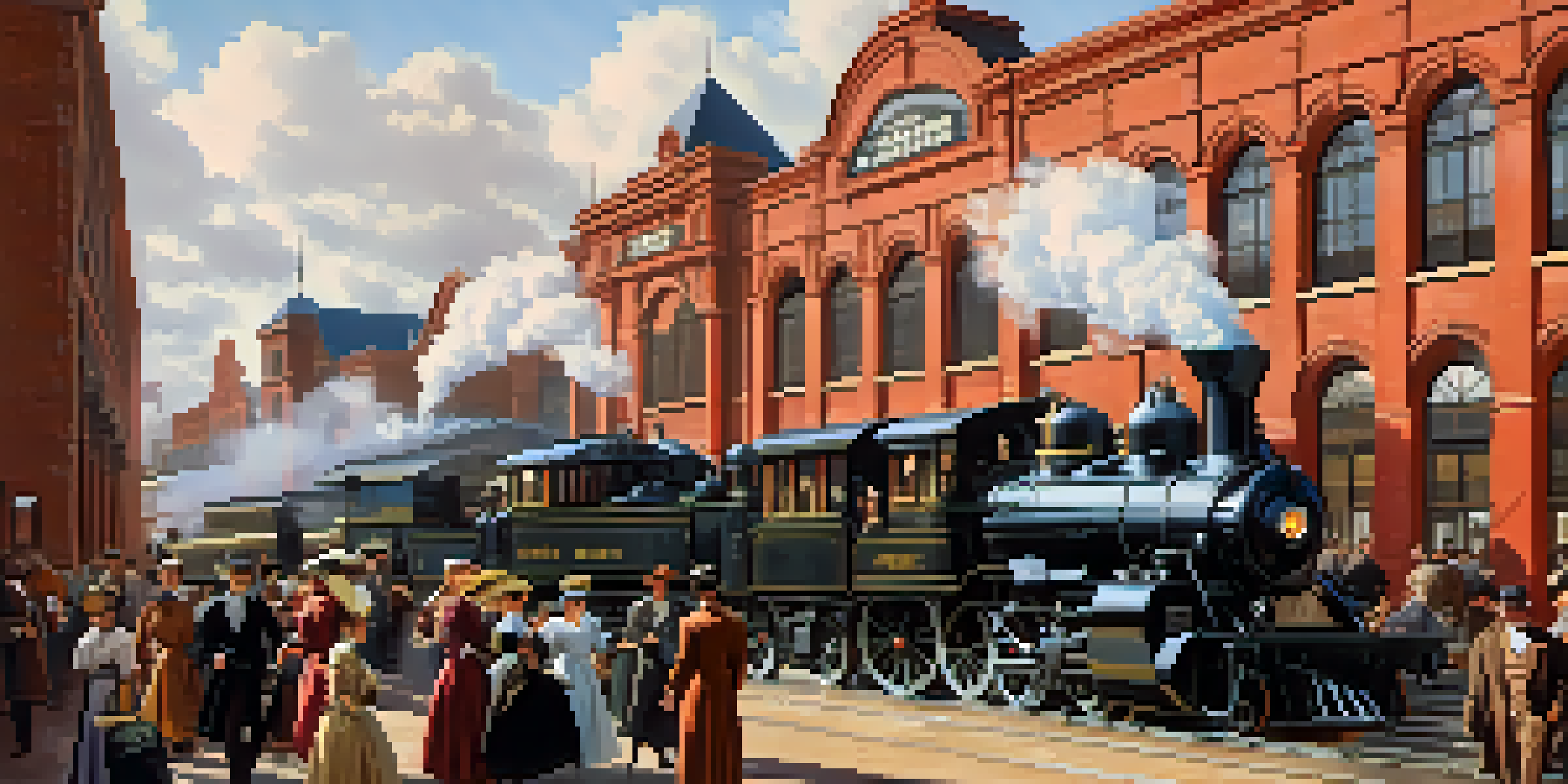The Impact of Railroads on Atlanta's Early Development

The Birth of Atlanta: A Transportation Hub
In the early 19th century, Atlanta was just a small settlement known as Terminus, where several railroads converged. This unique geographical advantage attracted businesses and settlers, eager to capitalize on the transportation opportunities. The arrival of the railroad in 1845 marked a pivotal moment, transforming the area into a bustling hub that would soon draw people from various regions.
The railroad is a remarkable symbol of American ingenuity and progress, connecting people and places in ways previously unimaginable.
As more railroads established routes through Atlanta, the city began to flourish economically. The influx of goods and services brought prosperity, leading to the development of new industries and job opportunities. This rapid growth not only changed the landscape but also the demographic makeup of the city, as many sought to benefit from the thriving economy.
Ultimately, the railroads were more than just tracks; they were the lifelines of Atlanta's early development. They connected the city to vital markets, facilitating trade and commerce. This connectivity laid the groundwork for Atlanta's future as a major economic center in the Southeast.
Economic Growth Fueled by Railroads
The introduction of railroads created a significant boost in Atlanta's economy, enabling the efficient transport of agricultural products and raw materials. Farmers from surrounding areas could now easily ship their goods to urban markets, stimulating growth in both sectors. This symbiotic relationship helped solidify Atlanta's position as a key player in the Southern economy.

With the railroads facilitating trade, numerous businesses began to spring up around the rail lines, creating jobs and increasing local wealth. From warehouses to factories, the infrastructure built around the railroads fueled an economic boom that attracted investments and innovation. This growth was not just limited to industry; retail and services also thrived in the bustling city.
Railroads Sparked Atlanta's Growth
The arrival of railroads transformed Atlanta from a small settlement into a thriving economic hub, attracting businesses and settlers alike.
Moreover, the railroads helped diversify Atlanta's economy, allowing it to adapt to changing market demands. As the city transformed, it became increasingly resilient, demonstrating the powerful role rail transportation played in shaping its economic landscape.
Cultural Exchange and Diversity Through Railroads
The railroads did more than just transport goods; they also facilitated the movement of people. As travelers flocked to Atlanta, they brought with them diverse cultures, ideas, and traditions. This influx enriched the local community, creating a vibrant tapestry of influences that would define Atlanta's character.
Transportation is a vital part of our economy, and railroads have always been the backbone of successful commerce.
With people from different backgrounds settling in the city, Atlanta became a melting pot of cultures. This diversity fostered a dynamic social environment, leading to the establishment of new communities, neighborhoods, and cultural institutions. Events that celebrated this variety, such as festivals and fairs, became increasingly popular, further uniting the populace.
As a result, the railroads not only connected cities but also connected people. They played a crucial role in building a community that thrived on diversity, promoting a sense of belonging and shared experiences among its residents.
The Role of Railroads in Atlanta's Civil War History
During the Civil War, Atlanta became a strategic target due to its significance as a railroad hub. Control of the railroads meant control of resources and troop movements, making the city a focal point of military operations. As a result, the railroads became a symbol of the struggle for dominance between the Union and Confederate forces.
The battles fought in and around Atlanta highlighted the importance of the railroads in wartime logistics. The city endured significant destruction, but its rail infrastructure was later rebuilt, proving essential for the post-war recovery. This resilience showcased the adaptability of Atlanta's economy and its communities, even in the face of adversity.
Cultural Diversity Through Connectivity
Railroads facilitated the movement of people into Atlanta, enriching the city's culture and fostering a vibrant, diverse community.
Moreover, the Civil War's impact on the railroads shaped the city's identity. The scars of battle and the subsequent reconstruction efforts became intertwined with Atlanta's narrative, influencing its cultural and historical significance in the years to come.
Urban Development Driven by Railroads
As railroads expanded, they prompted urban development in Atlanta, leading to the creation of neighborhoods and commercial districts. The convenience of train travel encouraged people to move closer to the stations, spurring real estate development and infrastructure improvements. This growth established the foundation for modern Atlanta's layout.
Railroads also influenced the design of the city, with major thoroughfares aligning with rail lines. This pattern facilitated accessibility and connectivity, making it easier for residents and visitors to navigate the burgeoning metropolis. The influence of railroads can still be observed today in Atlanta's urban planning and transportation systems.
Ultimately, the railroads played a crucial role in shaping the physical landscape of Atlanta, laying the groundwork for its future expansion. The city evolved into a modern urban center, with the railroads serving as a catalyst for development and progress.
Railroad Innovations and Their Impact on Atlanta
The growth of railroads in Atlanta was accompanied by significant technological innovations, such as the introduction of steam locomotives and improved track materials. These advancements enhanced efficiency and safety, making rail travel more attractive for both passengers and freight. The resulting increase in rail traffic helped solidify Atlanta's role as a transportation powerhouse.
Innovations in communication, such as the telegraph, also played a crucial role in the railroad industry. They allowed for better coordination of train schedules and operations, reducing delays and improving service reliability. This increased efficiency had a ripple effect on the local economy, as businesses could rely on timely deliveries and shipments.
Railroads Shaped Urban Development
The expansion of railroads drove urban development, influencing Atlanta's layout and infrastructure, which continues to impact the city today.
As these innovations took hold, they not only transformed the railroads but also enriched the overall experience of life in Atlanta. The city became synonymous with progress and modernity, showcasing how technological advancements could shape urban development and economic growth.
Legacy of Railroads in Atlanta Today
The legacy of the railroads continues to influence Atlanta's identity and development. While the original rail lines may have evolved, their impact remains visible in the city's transportation infrastructure, including airports and public transit systems. The principles of connectivity and accessibility established by early railroads still guide urban planning decisions today.
Furthermore, the historical significance of railroads is celebrated in Atlanta's culture, as seen in museums and heritage sites that highlight the city’s transportation history. This recognition fosters a sense of pride among residents, connecting them to their city's past while promoting awareness of its evolution.

Ultimately, the railroads were instrumental in shaping Atlanta into the dynamic city it is today. Their influence can be seen in various aspects of life, from commerce to culture, ensuring that the spirit of innovation and progress continues to thrive.